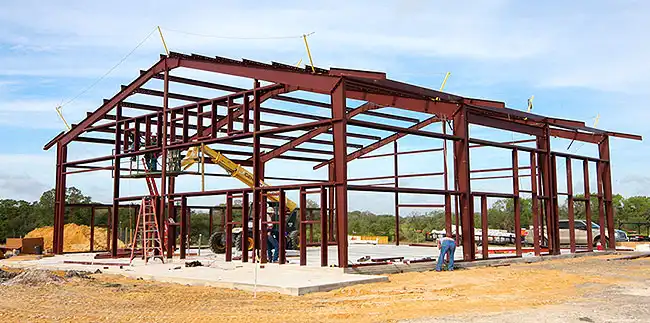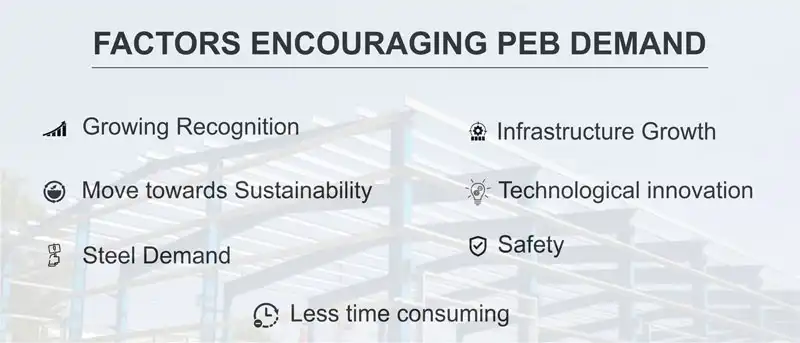The major focus of the construction sector is towards faster construction and PEB is well suited for the same. It is gradually gaining popularity and the acceptance level has increased in the last few years. The role of PEB has widened and it is being used for various applications now. The shift from in situ construction to factory-controlled pre-engineered high-quality construction has changed the requirement of engineering, materials, and skills for the construction industry. Every structure demands Stability, Strength, and Serviceability. Any lack of either of these might result in collapse. Stability, strength, and serviceability can only be achieved through design principles. In India, most often structural steel has traditionally been fabricated on-site. This was due to the lack of infrastructure for transporting heavy sections from an off-site work-shop to project site. Also one needs to consider the constraint of space at a fabrication workshop. This is exacerbated by the problem of inexpensive skilled labour. Therefore choosing the correct type is mandatory.
Market Potential of PEB:
The heightened emphasis on green building construction is also poised to push market expansion. For instance, to increase energy-efficiency, many PEB manufacturers have developed high efficiency windows and insulation for roofs, walls, ceilings & floors. Many leading international and domestic market participants are increasingly scouting for opportunities by adopting multiple business strategies such as venturing into engineering design, project contracting, manufacturing heavy structural steel buildings, and focusing on vertical integration whereas, merger & acquisition strategy will support them to grow inorganically and enable them to broaden their geographic reach and product portfolios.
The usage of PEBs across various applications has widened the scope of the market for PEB in India. The need for less time consuming and cost effective construction with high aesthetic values have helped the market for PEB grow in all major sectors such as commercial, industrial and infrastructure. In addition, due to various government policies, the number of SEZs in India is growing significantly.

Main Applications of PEB:
- Warehouses
- Factories
- Offices
- Workshops
- Gas Stations
- Vehicle Parking Sheds
- Showrooms
- Aircraft Hangars
- Metro Stations
- Schools
- Recreational
- Indoor Stadium Roofs
- Outdoor Stadium Canopies
- Bridges
- Railway Platform Shelters
Warehousing Demand for PEB
The warehousing sector has been one of the key demand drivers for the PEB industry in India over the last decade. The good old concept of “godowns” has been all but buried in India. There has been growing realization that a warehouse is much more than a place to stock goods. It is sometimes specialized to store a certain type of goods, for eg., cold storage units that are typically a part of the pharmaceutical and food & beverage industry.
It can also be a place where the final customer sorting takes place in this day and age of e-commerce, where customers can order products online. It is also a place in certain types of industries where even the final fabrication takes place. All these factors have increased focus on specialized solutions and this is where the PEB suppliers with their readymade solutions have stepped in. Warehouses, along with industrial buildings presently constitute a huge market share of PEBs in India.
The warehousing sector is fast catching the growth path mainly because of government’s support of creating dedicated food parks across India; setting up of warehouses in rural and semi-urban areas for storage of food grains, vegetables, fruits, etc.; recent e-commerce boom leading to dedicated warehouses for storage of products across India to be delivered within fraction of time by all these companies; dedicated logistics parks by private logistic players; warehouses by all other companies from various industry segments for their own purposes and many other reasons.
Retailing Demand
Retail sector that has embraced PEBs in a major way in the western world and it could be the same in the case of India. Apart from the boom in the retail sector in the metros, a huge untapped area lies in the hinterlands of the country. Rural retailing is an area that offers immense scope of growth for the PEB industry. A few sporadic steps have been taken by some of the leading players to tap this vast market and it could well prove the trigger for bigger things in the future
The labour cost on PEBs is also less as most of the building comes partially constructed. In the case of industrial and commercial projects, prefabrication allows, minimization of onsite workload, since a vast majority of the work is carried out offsite, eliminating most of the onsite works such as welding and bolting of connections, pre-assembling of smaller components and also a reduction in the number of onsite lifting requirements.
PEBs are extremely durable, strong enough to withstand every kind of climatic conditions, ranging from heavy snowfall to high winds or heat, a factor that has made them a favorite for industrial and commercial buildings, with demand picking up on the residential side too, in recent times. The technology also enables lower lifecycle cost, as compared to conventional methods of construction, a fact that is not lost on the modern day Indian contractor. The foundation for one is easier to construct, being lightweight and consisting of standard sections and connections. This saves erection cost and time. Owing to the government’s initiation of the ‘Smart City’ Initiation’, there is a upsurging demand of PEB even more.

Conclusion
The growth of pre-engineered building market is driven by rapidly growing industrialization & urbanization in emerging economies. In addition, rise in the number of e-retailers are resulting in increased demand for warehouses, thus supplementing the market growth. However, certain disadvantages associated with pre-engineered buildings such as their susceptibility to corrosion, low thermal resistivity, and reduced fire resistance hamper the market growth.

